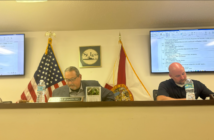BY GREG ROBINSON – Lions’ Pride Multimedia Editor
On Thursday, March 3 at approximately 10:10 a.m., a delivery truck transporting equipment drove over a fire hydrant near the on-campus construction, causing a pipe to break and water to flood the surrounding area. Since the hydrant was connected to the main campus water line, the water pressure for Saint Leo had to be suspended while the hydrant was capped off.
Workers spent over six hours Thursday attempting to cap the fire hydrant instead of repairing it since the hydrant was due to be moved to a different location anyway. After capping the hydrant, the pressure to the main campus was restored around 5 p.m. Plant Operations was in charge of killing the water pressure to campus, which was a necessity because the hydrant’s line could not be isolated from the main water pipe.
The prolonged exposure of the main water pipe, while workers capped the hydrant, necessitated a precautionary boil notice being put in place. Alicia Ridley, Risk Management at Saint Leo, explained why.
“In situations that involve things like this where there’s a large number of people that could be affected, the Department of Health steps in and gets involved,” Ridley said.
To repair the hydrant and adequately cap it, a large area around the cement hydrant mount had to be dug out, requiring several workers and heavy equipment. This was done in conjunction with Simplex Grinnel, an outsourced company that handles Saint Leo University’s hydrants, sprinkler systems, and fire safety. However, this prolonged exposure to the soil required the precautionary boil notice.
“Anytime that you have a break in a water main, or a pipe that leads directly to a large water main, there is the possibility that the water in the pipe has been contaminated because it’s been exposed. We are required by statutory law anytime something like that happens to issue a boil water notice as a precautionary measure in case there were any contaminants that made it into the pipe,” Ridley said.
Despite the precautionary notice being in place for five days, the measure was merely preemptive. The campus water supply was not in direct contact with dangerous chemicals or pollutants, nor was the structural integrity of the main pipe comprised. The warning was put in place simply because the main water pipe was exposed to open air while the hydrant was capped.
The school did incur costs related to the repair of the hydrant as well as fixing the mainline. Exact costs were not made available at this time. In addition to the money spent on repairs, the university is allotted a certain quantity of water per month. If the university goes over that limit, additional charges could be levied by the county.
The process of lifting the boil water notice was also explained by Ridley. Although the Department of Health didn’t require the three separate tests done on March 4, 7, and 8, the university felt it better to be cautious and conduct extra testing.
“To rescind the boil water notice, we [the university]have to take bacterial samples from all over campus at different water stations and send those samples off to a certified lab. If they come back clean because we’re a private water source, we can lift the boil water notice,” said Ridley.
This incident was unrelated to the other water contamination incidents in the recent past occurring in both deChantal and St. Edward’s halls. Those contamination notices were a result of old pipes. The replacement of those pipes is something the university is working into future budgets.
Students living on campus were affected by both the pressure shutdown on Thursday and the subsequent boil notice, which resulted in limited beverages available in the dining hall and the Lions’ Lair.
“I wished that they had offered students juice or better drink options during the time the machines were down instead of limited amounts of flavorless punch or lemonade,” Junior Ryan McArdell said.
The university responded to the crisis in a number of ways. Cases of bottled water kept on campus for large events such as graduation were made available to students and staff. More than 250 five-gallon water jugs were used in the five days of the boil water notice with several more waiting to be brought out if necessary.
One effort by the university that may have gone unnoticed was the work of Plant Operations. On the day of the pressure shutdown, they covered as much of campus as they could with 5-gallon buckets of water to put in the toilets so they would flush.
In addition to the interruption of students’ lives, the pressure shutdown halted construction on the Donald R. Tapia School of Business for the day. The incident, however, had no impact on the Spring Fling events.
Ridley and the administration staff of Saint Leo University were sympathetic to the situation, however, and are looking at new contingency plans for future incidents such as this. Ridley said the staff were without toilets for several hours as well and understood the situation was difficult for students.
“I think the general consensus was that the students were very upset, and I can’t blame them,” said Ridley.





